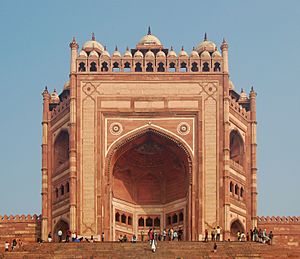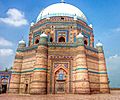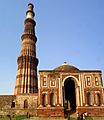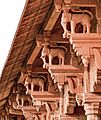Indo-Islamic architecture facts for kids

Indo-Islamic architecture is a special kind of building style found in the Indian subcontinent. It's also sometimes called Indo-Persian architecture. This style mixes ideas from architecture in India with designs from West and Central Asia. It started a long time ago when Islamic empires ruled parts of India. This unique style began around 1193 when Delhi became the main city for the Ghurid dynasty. Over time, different ruling families added their own touches, bringing in ideas from Persian and Turkic building styles.
Contents
What is Indo-Islamic Architecture?
Indo-Islamic architecture combines the strong, traditional building methods of India with the beautiful, detailed designs from Islamic cultures. When new rulers came to India, they brought their own ways of building. They used local Indian builders and materials, which led to a wonderful mix of styles. This created buildings that were both strong and very artistic.
Key Features of This Style
This architecture often includes several special features. You might see grand domes, tall minarets (towers), and large arches. Many buildings also have detailed carvings and patterns, often using geometric shapes or flower designs. Courtyards are common, providing open spaces within the buildings. Water features like fountains and pools are also often part of the design, making places feel cool and peaceful.
How Did it Develop?
The development of Indo-Islamic architecture happened over many centuries. Each ruling family, like the Delhi Sultanate or the Mughals, added their own unique ideas. For example, early buildings might have used simpler arches. Later, builders learned to create more complex and beautiful arches. The materials used also changed, from local stone to fine marble, especially during the Mughal period.
Famous Examples of Indo-Islamic Buildings
Many famous buildings in India and Pakistan show off the beauty of Indo-Islamic architecture. These include grand mosques, impressive tombs, and strong forts. Each one tells a story about the time it was built and the people who created it.
The Delhi Sultanate Period (1206–1526)
During the time of the Delhi Sultanate, some of the earliest and most important Indo-Islamic buildings were constructed. These buildings often used strong, simple designs. They showed the first blending of Indian and Islamic styles.
Early Structures in Delhi
The Qutb Complex in Delhi is a great example from this period. It includes the Qutb Minar, a very tall tower that started being built around 1200. You can also see the Alai Darwaza gatehouse, built in 1311, which has some of the first "true" arches in India. The Tomb of Balban (who died in 1287) is another early example of these new arch designs.
Other Sultanate Buildings
Beyond Delhi, other important buildings were made. The Tomb of Shah Rukn-e-Alam in Multan, Pakistan, built between 1320 and 1324, is known for its large dome. The Adhai Din Ka Jhonpra mosque in Ajmer, built around 1229, shows unique screen arches. The Jama Mosque Gulbarga (built in 1367) is another significant structure from this time.
The Mughal Empire Period (1526–1857)
The Mughal Empire brought a golden age for Indo-Islamic architecture. Mughal buildings are known for their grandeur, symmetry, and use of expensive materials like white marble and red sandstone.
Iconic Mughal Monuments
The Taj Mahal in Agra, India, is probably the most famous example of Mughal architecture. It's a beautiful tomb built for an emperor's wife and is known for its perfect symmetry and white marble. Humayun's Tomb in Delhi, built in 1569-70, was one of the first fully developed Mughal imperial tombs and inspired the Taj Mahal.
Mughal Forts and Mosques
The Red Fort in Delhi and the Lahore Fort are huge, strong forts built by the Mughals. They show how the Mughals combined defense with beautiful design. The Jama Masjid in Delhi is one of the largest mosques in India, built with red sandstone and white marble. The Badshahi Mosque in Lahore, Pakistan, built in the late 1600s, is another impressive example of late Mughal style.
Other Mughal Creations
Fatehpur Sikri, near Agra, is an entire city built by Emperor Akbar. It includes the massive Buland Darwaza gate. Many Mughal buildings, like Akbar's Tomb in Agra, use a mix of red sandstone and white marble. The Bibi Ka Maqbara in Aurangabad, India, is sometimes called the "Taj of Deccan" because it looks similar to the Taj Mahal.
Regional Styles of Indo-Islamic Architecture
While the Delhi Sultanate and Mughal styles are well-known, different regions in India and Pakistan also developed their own unique versions of Indo-Islamic architecture. These regional styles often blended local traditions even more closely with Islamic designs.
Deccani Architecture
In the Deccan region of India, a distinct style emerged. The Gol Gumbaz in Bijapur, built by the Bijapur Sultanate, has the world's second-largest pre-modern dome. The Charminar in Hyderabad, built in 1591, is a famous landmark with four tall minarets.
Bengali Architecture
In Bengal, buildings often used local materials like brick and terracotta. The Choto Sona Mosque (around 1500) and the Adina Mosque are examples of this style, known for their detailed terracotta carvings.
Gujarati Architecture
Gujarat developed a style that often included intricate stone carvings and detailed minarets. The Jama Mosque, Ahmedabad and the Sidi Saiyyed Mosque with its famous Jali (stone lattice work) are great examples.
Kashmiri Architecture
In Kashmir, the architecture often used wood and had unique roof designs to suit the local climate. The Aali Masjid and Khanqah-e-Moula in Srinagar show this distinct regional style.
Images for kids
-
Tomb of Shah Rukn-e-Alam (built 1320 to 1324) in Multan, Pakistan
-
The Qutb Minar (left, begun c. 1200) next to the Alai Darwaza gatehouse (1311); Qutb Complex in Delhi
-
Mausoleum of Iltutmish, Delhi, by 1236, with corbel arches
-
Interior of the hypostyle hall of the Adina Mosque
-
Aali Masjid in Srinagar, Kashmir.
-
Humayun's Tomb, Delhi, the first fully developed Mughal imperial tomb, 1569-70
-
King's Gate at Fatehpur Sikri, near Agra
-
The Taj Mahal in Agra, India, widely considered the pinnacle of Islamic architecture in the subcontinent.
-
The Rumi Darwaza in Lucknow, 1784, from the rear, during flooding.
-
Screen of the Adhai Din Ka Jhonpra mosque, Ajmer, c. 1229; Corbel arches, some cusped.
-
Gol Gumbaz built by the Bijapur Sultanate in Deccani style, the world's 2nd largest pre-modern dome following the Hagia Sophia in Istanbul.
-
The use of elephant-shaped column brackets in buildings of the Lahore Fort reflects Hindu influences on Mughal Architecture during the reign of Akbar.
-
The Darwaza-i-Rauza (Great Gate) of the Taj Mahal.
-
Jama Masjid, Delhi, one of the largest mosques in India.
-
Tomb of Nithar Begum at Khusro Bagh, Allahabad, India.
-
Akbar's Tomb at Agra, India uses red sandstone and white marble, like many of the Mughal monuments. The Taj Mahal is a notable exception, as it uses only marble.
-
Bibi Ka Maqbara is a tomb located in Aurangabad, Maharashtra, India, which was built by Mughal emperor Aurangzeb's son Azam Shah in the memory of his mother.
-
Badshahi mosque in Lahore, Pakistan, late Mughal, built 1673–1674.




























































